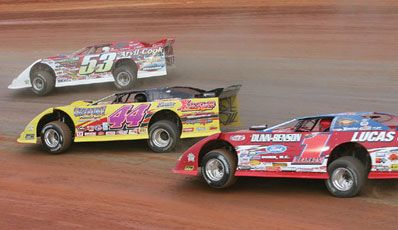
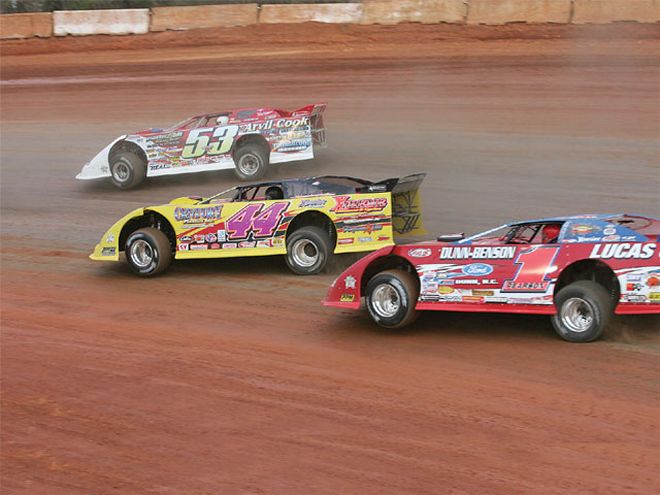 A four-bar dirt Late Model rear suspension is designed to have a large range of rear steer. The adjustability allows the racer to make adjustments for the changing conditions that occur on dirt surfaces. The attitude of the car on dry-slick tracks can be quite radical.
A four-bar dirt Late Model rear suspension is designed to have a large range of rear steer. The adjustability allows the racer to make adjustments for the changing conditions that occur on dirt surfaces. The attitude of the car on dry-slick tracks can be quite radical.
The use of rear steer has changed in the past few years. What was common in the mid-to-late '90s is not necessarily the fastest way to go in the 2000's. Technology races on, and we discover new and innovative ways to go faster. As setup philosophies change, so do other setup components that are affected by the setup evolution. Rear steer is one of those effects that must conform to the basic setup package.
Rear steer in a circle track race car is a condition caused by suspension movement and sometimes dynamic forces of acceleration. Under the right conditions, rear steer can be beneficial and enhance performance. Under the wrong conditions, it can ruin your performance. We do not necessarily need to know the exact amounts of rear steer our cars are subjected to, but we need to have a solid understanding of exactly what produces rear steer and what effect rear steer has on the handling of our cars.
The technology related to rear steer for asphalt and dirt is somewhat different. There are a few similarities and many differences in how we evaluate and use rear steer for each group, so we will analyze them separately.
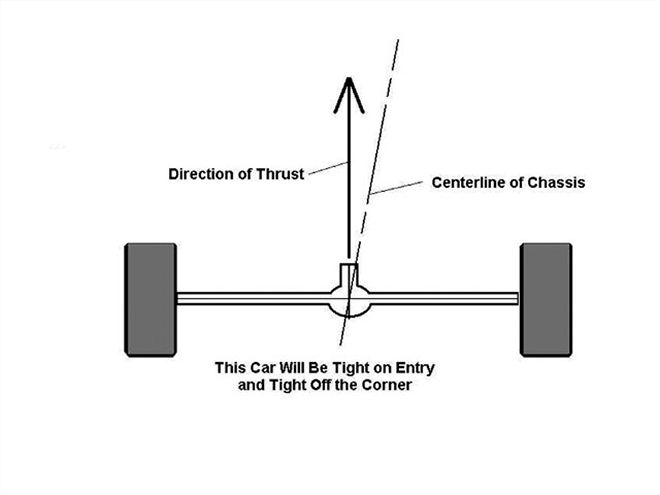 With the rear end pointed to the left of centerline, steering causes the rear of the car to want to run left under the front end, causing a very tight condition, especially under acceleration.
With the rear end pointed to the left of centerline, steering causes the rear of the car to want to run left under the front end, causing a very tight condition, especially under acceleration.
First and foremost, rear steer is mostly caused by rear suspension movement. As the rear of the car dives and/or rises, and rolls, the control arms, which locate the rear end fore and aft, can cause the wheels to move forward or to the rear. Obviously, if both of the wheels did not move or moved in the same direction by the same amount, we would have zero rear steer. When one wheel moves more than the other or in a different direction, we have rear steer.
Rear steer can either tighten a car or make it very loose. Not only does the condition of rear steer affect the entry and middle handling balance, it also affects the handling under acceleration due to the thrust angle of the rear end being either right or left of the centerline of the car. In dirt racing, it may be advantageous to incorporate a large amount of rear steer under certain conditions.
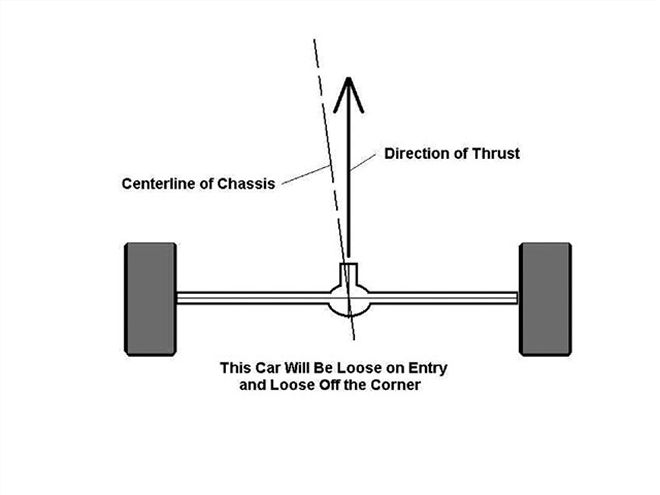 With the rear end pointed to the right of centerline, the car is freed up going in and through the middle, and will possibly be loose off the corners with the rear end wanting to run around to the right of the front.
With the rear end pointed to the right of centerline, the car is freed up going in and through the middle, and will possibly be loose off the corners with the rear end wanting to run around to the right of the front.
Is rear steer an important tuning tool? We asked Joe Garrison of GRT Race Cars and Mark Richards of Rocket Chassis if rear steer was important in dirt racing, and both said having rear steer capability in a dirt car was critical. "Rear steer helps the driver get the rear end around on dry-slick tracks without having to break the rear tires loose," said Garrison. Richards said, "If the driver has to counter steer the car a lot, you need more rear steer."
Keith Masters of MasterSbilt Race Car Chassis said, "The reason chassis builders build four-bar cars is rear steer. The entry is more important to design than the exit, as far as rear steer is concerned." That echoes what Garrison said in that keeping the rear tires connected to the ground going in and through the middle helps provide traction offthe corners, too. So a smooth entry provides a faster exit.
We also talked with Sandy Goddard of Warrior Race Cars, and he told us that his group of racers work with rear steer less than some other dirt teams, although he feels that using a degree of rear steer is very important at times. He said, "Rear steer definitely helps get into the corners on dry-slick tracks, but you can put too much rear steer into the rear suspension. A lot of guys take that to extremes."
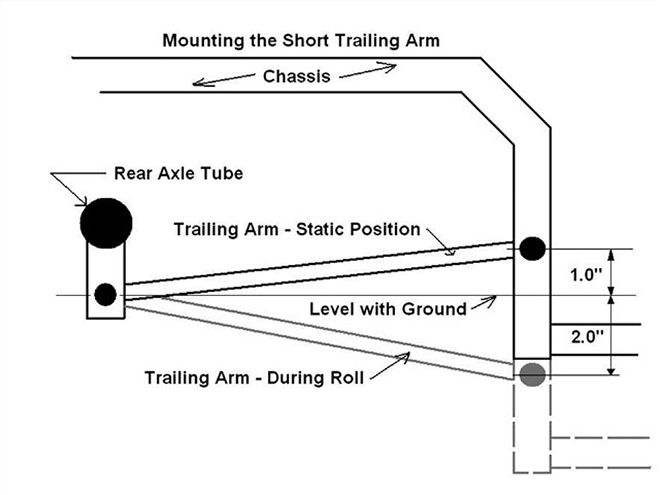 The three-link rear suspension system can produce rear steer in both directions. As the chassis moves down on the right side, the right-rear (RR) wheel moves back as the front mount approaches the height of the rear mounting point. As the front mounting point continues to move down, the RR wheel is pulled forward. Normally, to produce a small amount of rear steer to the left on asphalt, we mount the front pivot point one third of the total travel distance higher than the rear pivot.
The three-link rear suspension system can produce rear steer in both directions. As the chassis moves down on the right side, the right-rear (RR) wheel moves back as the front mount approaches the height of the rear mounting point. As the front mounting point continues to move down, the RR wheel is pulled forward. Normally, to produce a small amount of rear steer to the left on asphalt, we mount the front pivot point one third of the total travel distance higher than the rear pivot.
C.J. Rayburn, of Rayburn Race Cars, is a driver as well as a car builder and echoes much of what the other builders have to say. "We have always wanted rear steer," he says. "Rear steer is important in any design of dirt car." Rayburn builds the swing-arm type of rear suspension, and those cars have multiple holes so that the angles of the control links can be altered to produce more or less rear steer.
A rear end that is steered to the left of centerline will cause the thrust angle to be to the left of centerline and make the car tighter on entry and tighter on exit under acceleration. A rear end that is steered to the right of centerline causes the thrust angle to be pointed to the right of centerline and makes the car looser on entry and looser on exit under acceleration. Knowing these basics, we need to look at each type of racing to see how rear steer affects each type of car and how we might improve our performance using rear steer.
The asphalt racing surface provides a lot of traction, even on those flat, slick tracks. Because there is very little slip of the tires on asphalt, the range of useable rear steer is very small. The suspension should never steer the rear end to the right of centerline on asphalt. It has been a practice for teams to align the rear end and/or have it steer slightly to the right to fix a tight mid-corner condition, but this goes into the category of crutches and should not be necessary if the car is set up properly otherwise.
Asphalt stock cars have four predominant rear suspension systems, and all of them produce some amount of rear steer. They are as follows:
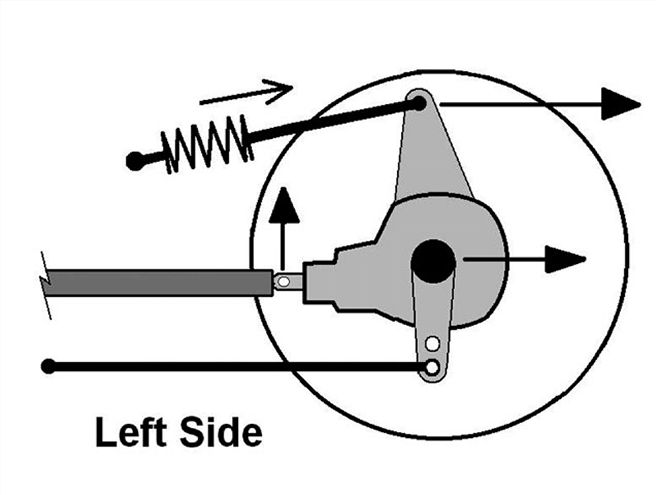 This causes a slight amount of rear steer to the left. The exact amount depends on the difference in height of the mounting points and the amount of third-link travel.
This causes a slight amount of rear steer to the left. The exact amount depends on the difference in height of the mounting points and the amount of third-link travel.
The Asphalt Three-Link. The three-link rear suspension system has two trailing arms forward of the rear end and mounted near the rear tires, and a third link is mounted atop the rear differential, which controls rear end wrap-up. The trailing arms can be mounted parallel to the centerline of the car or angled with the front mounts closer to centerline.
Rear steer in this system is caused by chassis movement, which can produce several secondary effects. Usually, the RR corner of the chassis moves more than the left rear (LR), and on most flat-to-medium banked tracks, the LR moves very little. This has been confirmed by studying data from onboard computer systems during testing that shows shock travel amounts in the turns. The LR shock mostly seems to move between 1/2 inch in rebound and up to 1/2 inch in compression during the entire lap, whereas the RR shock shows 3 to 4 inches or more of travel, depending on the spring rates used.
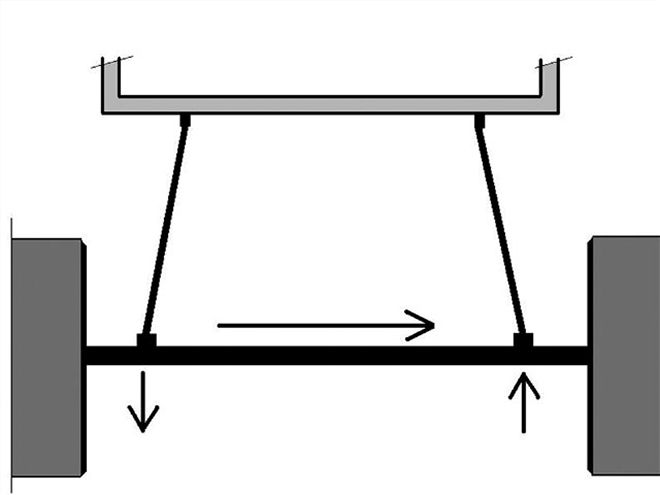 Some three-link rear suspensions are built with the trailing arms angled from a top view, with the front mounts located closer to the car's centerline than the rear mounts. This creates some amount of rear steer if the rear end moves laterally as the chassis rolls. This type of rear steer will tighten the car if the rear end moves to the right as the car rolls. The downside to this rear steer is that it will tighten the car in the middle of the turns as well as off the corner.
Some three-link rear suspensions are built with the trailing arms angled from a top view, with the front mounts located closer to the car's centerline than the rear mounts. This creates some amount of rear steer if the rear end moves laterally as the chassis rolls. This type of rear steer will tighten the car if the rear end moves to the right as the car rolls. The downside to this rear steer is that it will tighten the car in the middle of the turns as well as off the corner.
That would mean that on most asphalt three-link cars, the RR trailing arm mostly controls rear steer due to body dive and roll. We usually need to position the angle of the trailing arm so that the front mount is higher than the rear mount by roughly one-third the distance that the front mount will move down during cornering. The variation of height for the RR trailing arm is very small. Changes in the height of the front of the trailing arm, which are as small as 1/4 inch, can be felt by the driver.
A way to produce rear steer only under acceleration is by staggering the height of the two trailing arms in the three-link system when using a pull bar upper third link. If we mount the left-side trailing arm lower than the right-side trailing arm, as the rear end rotates under acceleration due to the pull bar extending, the LR wheel will move rearward more so than the RR wheel, causing rear steer to the left to a small degree. This promotes forward bite without causing the car to be tight on entry or in the middle of the turns.
Another configuration that promotes rear steer is when the rear trailing arms are angled from a top view with the front mount closer to the centerline than the rear mounts. With this design, lateral movement of the rear end causes rear steer. If the Panhard bar is mounted on the right side of the chassis and level to the ground, then the rear end will be pulled to the right and the rear end will steer to the left when the chassis moves during cornering.
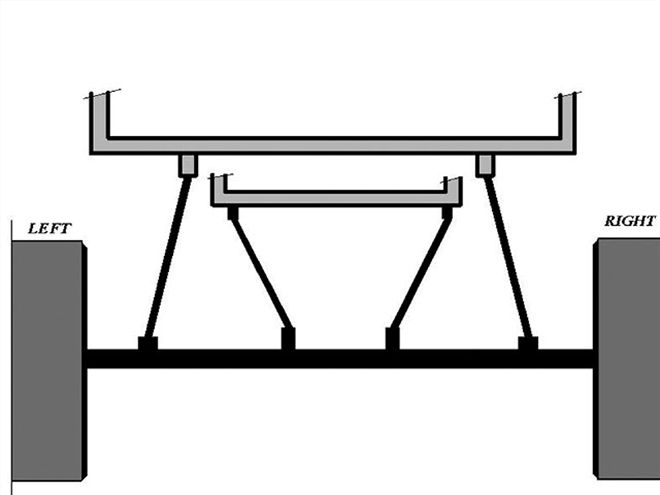 The metric four-link suspension has two links above the rear end and two links below the rear end. They are angled from a top view to prevent the rear end from moving side to side as the chassis rolls.
The metric four-link suspension has two links above the rear end and two links below the rear end. They are angled from a top view to prevent the rear end from moving side to side as the chassis rolls.
The Truck Arm System. Adapted from the design for a '64 Chevy truck, this system is used on many Late Model stock cars as well as vehicles in the three premier divisions of NASCAR: Craftsman Trucks, Busch cars, and Nextel Cup cars. This system only steers to the left and has a limited amount of steer. The roll of the chassis and the movement of the Panhard bar influence the amount of steer in these systems.
As far as the geometry related to rear steer is concerned, this is an ideal system. The amount of rear steer due to body roll is regulated by the height of the front mounts of the arms, which are always mounted lower than the rear axis of rotation, which is the axle. Rear steer amounts due to the Panhard bar angle are regulated by the angle, the same situation that exists with unparallel three-link lower arms. A downside to using the truck arm system is that a narrow spring base forms when the springs are mounted directly on top of the truck arms, resulting in a narrow spring base at the rear that doesn't resist roll very well.
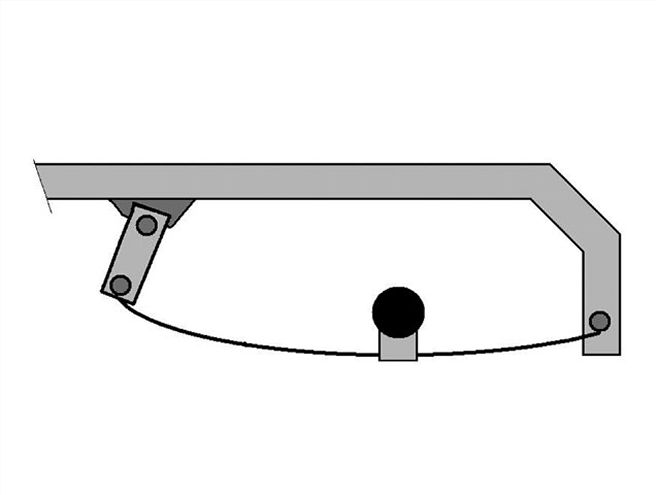 The leaf-spring suspension system usually has fixed mounts in the front and therefore no adjustment for amount of rear steer. The rear end stays mostly square in the car throughout the lap. The feedback we hear from the racers is that the leaf-spring rear suspension is good on tacky or wet tracks and not so good on dry-slick tracks.
The leaf-spring suspension system usually has fixed mounts in the front and therefore no adjustment for amount of rear steer. The rear end stays mostly square in the car throughout the lap. The feedback we hear from the racers is that the leaf-spring rear suspension is good on tacky or wet tracks and not so good on dry-slick tracks.
The Metric Four-Link System. The metric four-link is a widely used system that is built into some models of stock automobiles. It uses four links, as the name implies, that are not parallel to the centerline of the car. The top links are angled from a top view with the front pivots wider than the rear pivots. The lower links are angled from a top view with the front pivots closer to centerline than the rear pivots.
With this system, the rear end stays located by virtue of the opposing angles of the upper and lower links. There is also steer to the left, and because of the width of the front mounts of the lower controlling links, rear steer can be considerable. Under most current rules, there is no adjustment for amounts of rear steer with these systems.
Leaf-Spring Systems. The leaf-spring rear suspension system locates the rear end fore and aft as well as laterally using the leafs. There can be some amount of rear steer as the chassis rolls and squats, but it is usually minimal and mostly fixed as far as adjustability. The advantage of this system is that it keeps the rear end squared up and the thrust under acceleration straight ahead, if that is what is needed.
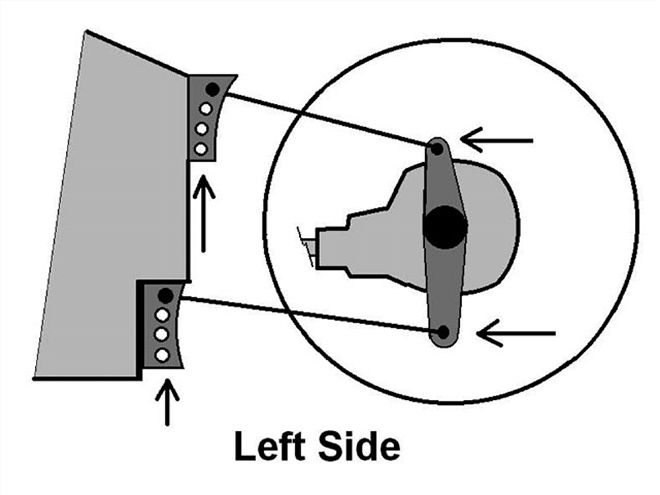 If the top bars on a four-bar car are set all the way to the top of the mounts, then as the car rolls up on the left side and down on the right side, the rear end will steer to the right quite a bit.
If the top bars on a four-bar car are set all the way to the top of the mounts, then as the car rolls up on the left side and down on the right side, the rear end will steer to the right quite a bit.
There are four types of rear suspensions used in most dirt cars that are significant to study regarding rear steer. Characteristics of the metric four-link and the leaf-spring systems are the same as discussed under the headings related to asphalt cars, so let's expand on the other two systems
Dirt Late Model cars can be designed with a considerable degree of adjustment for rear steer. Many teams use varying amounts of rear steer to adjust to constantly changing track conditions, a product of variations in moisture content that is so common in dirt racing. Other teams may just stick with a fixed location for the mounts in the rear end and adjust handling by other means.
A car may test fast in practice, qualifying, and maybe the heat races, but when the track changes it's out to lunch come feature time because of improper rear steer. Here's how each system functions and how they can be adjusted for the degree of rear steer.
The Standard Four-Bar System. The four-bar suspension is highly adjustable and can be made to steer wheels in both directions. The rule about never steering the rear end to the right on an asphalt car does not apply on a dirt car. There are times when we definitely want the rear to steer to the right.
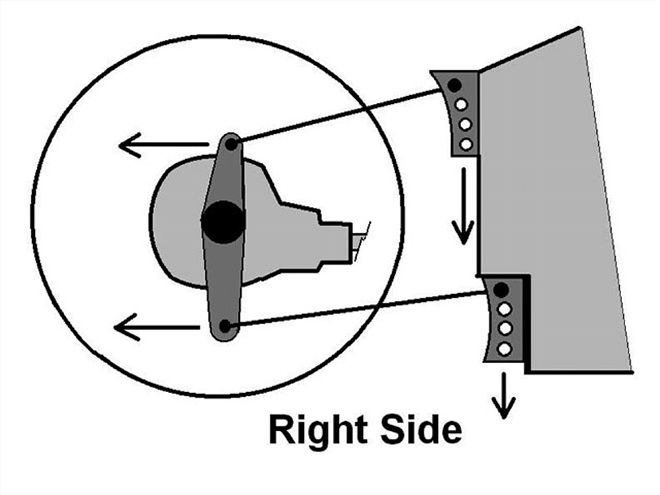 This helps the driver get the car turned to prepare to exit the corner and keeps the rear tires in contact with the track surface under extremely dry-slick conditions.
This helps the driver get the car turned to prepare to exit the corner and keeps the rear tires in contact with the track surface under extremely dry-slick conditions.
Depending on the angles of the trailing arms or bars, each rear wheel can be made to move to the front or rear. The roll angles and vertical movement on a dirt car can be very pronounced. With so much movement, we can plan our rear steer just about any way we need it
The bars can be mounted on one side of the car so only the wheel on that side moves to create the rear steer. If both sides are configured to move in opposite directions, then rear steer can be extreme in magnitude. The trend in the past few years has been to limit the degree of rear steer, even on dry-slick tracks.
On a tacky track, the team would do well to eliminate rear steer on both sides of the car. These conditions call for a driving line that is more straight ahead. When the track goes slick, especially dry slick, some rear steer may be needed. In the past, drivers would set the car up for exit off the corners by throwing the car sideways and breaking the rear tires loose.
In more recent years, teams have been setting the car up so the left side rises quite a bit. When limiting LR wheel movement, the LR tire does not tuck under the left front of the wheelwell as much as in the past.
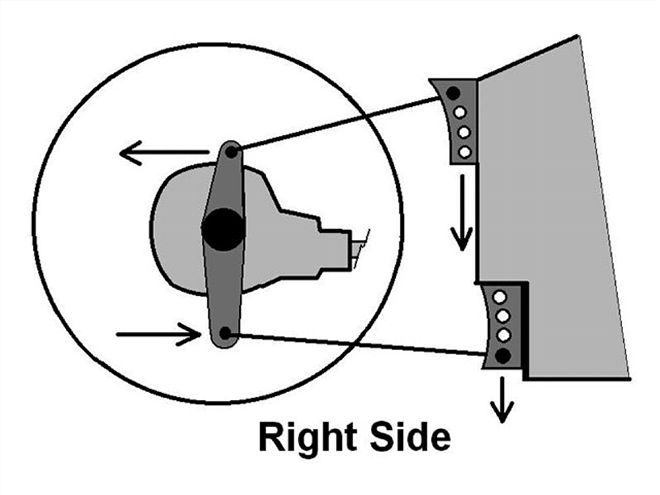 If the bars on a four-bar car are set in the correct holes, the movement of the top and bottom mounts at the rear end will compensate fore and aft, resulting in zero rear steer. This is best for tight, wet tracks on which rear steer cannot be used and the thrust needs to be pointed straight ahead.
If the bars on a four-bar car are set in the correct holes, the movement of the top and bottom mounts at the rear end will compensate fore and aft, resulting in zero rear steer. This is best for tight, wet tracks on which rear steer cannot be used and the thrust needs to be pointed straight ahead.
There are limits to how far we go in steering the car this way. One disadvantage was pointed out by Keith Masters. He said, "High left-rear loading does not increase traction." As the left side of the car travels up, the front of both of the trailing arms are angled upward so the LR tire tries to drive up under the chassis, loading the LR tire considerably.
We can have too much weight on the LR tire and lose traction and/or cause the car to push off the corners because of all the forward thrust concentrated in the LR tire. In racing, we have the maximum amount of traction from a pair of tires on the same axle if they are equally loaded. Excess loading of either the LR or RR tires decreases traction in most cases.
The Z-link rear suspension, or swing arm as it is sometimes called, is another system used on dirt cars. Compared to the four-bar system, it has more limited adjustment for rear steer and has worked well on the tighter and more highly banked racetracks because the rear end is pointed more straight ahead. Some manufacturers have added multiple mounting points on the front and rear chassis mounts. This helps make the rear steer characteristics more adjustable for the changing conditions.
According to Richards, the Z-link or swing arm suspension can have nearly as much rear steer as the four-link without the excessive loading of the LR tire. This comes with adding more adjustment holes and is beneficial if rear steer is needed.
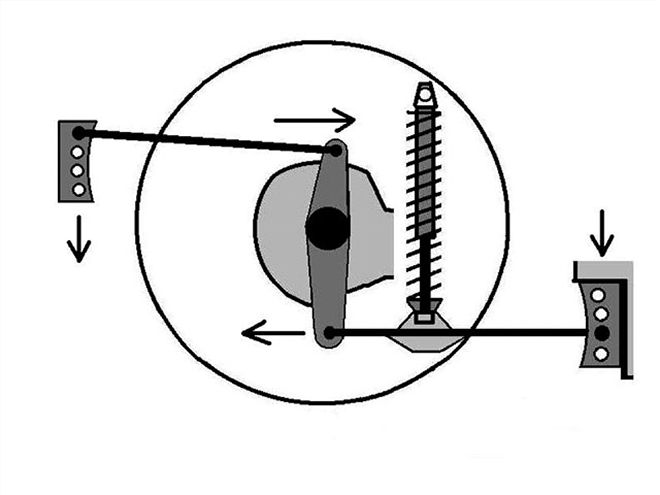 A Z-link suspension system uses a link extending from under the rear end forward to the chassis and one from the top of the rear end rearward to a mount on the chassis. The axle mounting points are on a birdcage that rotates on the axle housing. Most designs use mounting holes that would enable the team to make adjustments for the amount of rear steer in those cars. Note that the spring is mounted directly on the front link.
A Z-link suspension system uses a link extending from under the rear end forward to the chassis and one from the top of the rear end rearward to a mount on the chassis. The axle mounting points are on a birdcage that rotates on the axle housing. Most designs use mounting holes that would enable the team to make adjustments for the amount of rear steer in those cars. Note that the spring is mounted directly on the front link.
Most of the Z-link systems utilize a spring mounting system that attaches the coilover spring to the front link. This produces a motion ratio that causes the spring to move less than the rear end in relation to the chassis. Therefore, the rate that the car feels is much less, usually around 50 percent, than the actual installed spring rate. A 200-pound spring in a Z-link car feels more like a 100-pound spring in a four-bar car.
The chassis travel in a Z-link is enhanced compared to the four-link suspension when using the same installed spring rate, and this causes quite a bit of chassis travel and related rear steer. Teams need to take this rate difference into account.
We should learn to read the conditions of the track and tune the amount of rear steer. We need less for tacky and wet conditions and can add more rear steer as the track becomes more slick. In extreme dry-slick conditions, use some rear steer to the right to help the car rotate. This is accomplished by causing the RR wheel to move back and the LR wheel to move forward as the car rolls. Soft springs, a left-side chassis-mounted track bar, and easy-up shocks on the left side all promote the body roll that produces rear steer to the right.
On asphalt, do not make large changes to components that influence rear steer. Make small adjustments if you feel you need to, and when you find the correct amount of rear steer, stay there and tune the handling with the other components. When racing on dirt, watch the conditions and be prepared to make changes accordingly, not just to the setup, but also related to rear steer. That way, the car will stay as fast and balanced as it can be throughout all the changing conditions.